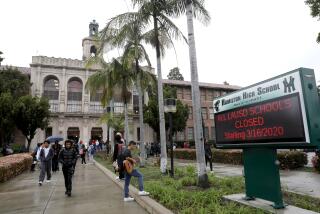L.A. Unified to Lose Millions From Drop in Enrollment
Enrollment in city schools will continue to drop by thousands of students next year, Los Angeles education officials said Tuesday, and the decline is expected to cost the Los Angeles Unified School District tens of millions of dollars in state funding.
The enrollment projections came to light when Supt. Roy Romer submitted a $7.5-billion budget for the coming school year to the Board of Education.
According to Romer’s proposed budget, about 20,000 fewer students will attend classes next year at the roughly 690 traditional campuses that dot the sprawling district, dropping enrollment to about 678,000. The loss would mark the fourth consecutive year the district has lost students. Last fall, district officials were caught off guard by a decline of 20,258 students for the current school year, which far exceeded their projections.
The number of students attending scores of independently run charter schools in the district, meanwhile, is expected to rise by about 5,000, bringing the district’s overall head count to about 712,000 children.
Because nearly all the funding a school district receives from state coffers is based on enrollment, the declining totals in traditional Los Angeles schools will cost the district an estimated $114 million. At the same time, the district will save about $40 million in costs because there will be fewer students to serve.
Despite the anticipated money loss, Romer presented a balanced budget, made possible largely because the state’s improving economy has increased overall funding to schools. In coming weeks, the seven-member school board will debate the allotments put forth by Romer before voting on the final budget in August.
At the center of Romer’s budget is a series of initiatives aimed at improving academics and safety in middle and high schools. The largest of the programs is a $36-million infusion that would improve science labs, modernize libraries and make other improvements at 17 of the district’s lowest-performing high schools. Romer has also called for money to be set aside to provide incentives to attract special education teachers and increase training for teachers.
But with the district in the early stages of contract negotiations with the teachers union, Romer said he had not built into the budget any raises for teachers.
The decline in enrollment has also had an effect on the district’s ambitious construction and repair projects, which aim to end severe overcrowding that has plagued schools for decades. For the final phase of the building project, district officials had envisioned the need to build 21 elementary schools to reach the goal of removing all students from cumbersome, year-round schedules. Now, however, with projected enrollment showing a continued decline for the next six to eight years, Romer said only 15 new elementary campuses are needed. He emphasized that no schools under construction or in the formal planning stages have been canceled because of the lower student figures.
Also Tuesday, board President Marlene Canter confirmed the members of a search committee that will play an integral role in selecting a replacement for Romer, who is expected to leave in the fall.
The committee will narrow the list of candidates to a group of finalists, from which the board will select a new superintendent. The members are Benjamin Chu, president of Kaiser Foundation Health Plan; state Sen. Martha Escutia (D-Whittier); Ron Gastelum, executive vice president of the Los Angeles Area Chamber of Commerce; Father Robert Lawton, president of Loyola Marymount University; Eliseo Medina, international executive vice president of the Service Employees International Union; California School Boards Assn. Executive Director Scott Plotkin; and state Assemblyman Mark Ridley-Thomas (D-Los Angeles).
More to Read
Sign up for Essential California
The most important California stories and recommendations in your inbox every morning.
You may occasionally receive promotional content from the Los Angeles Times.










